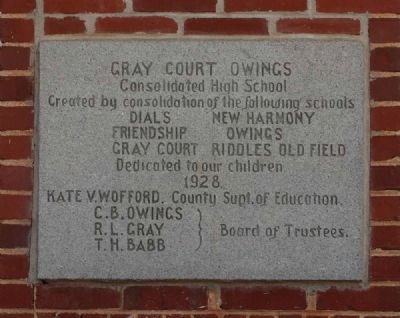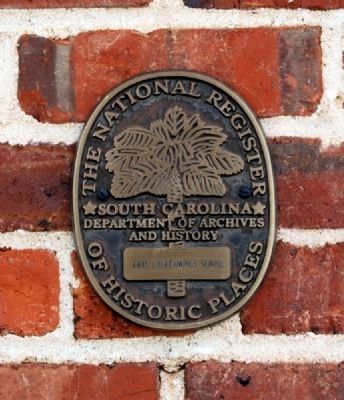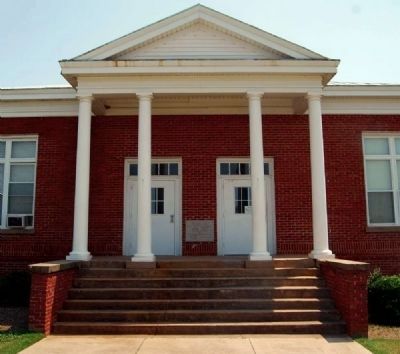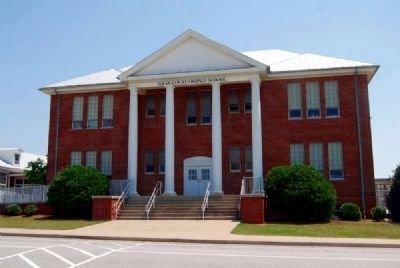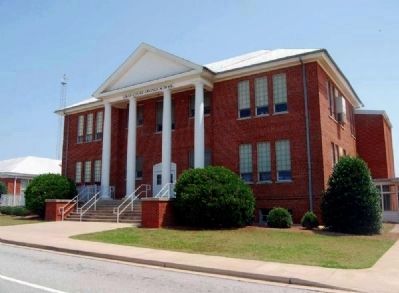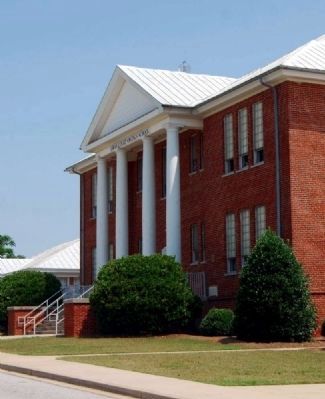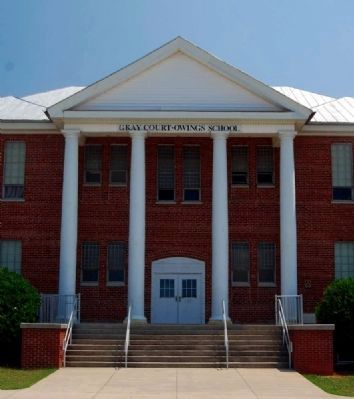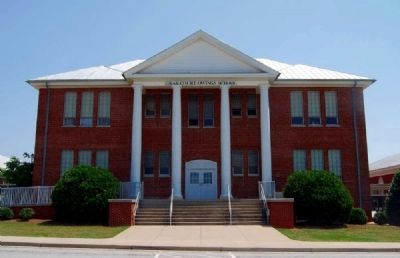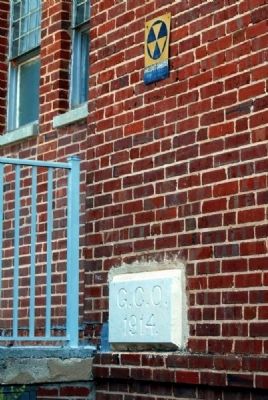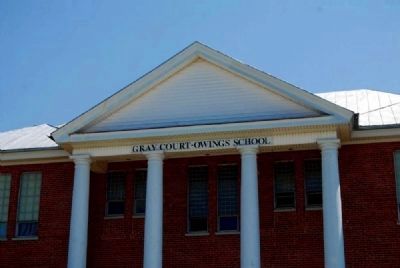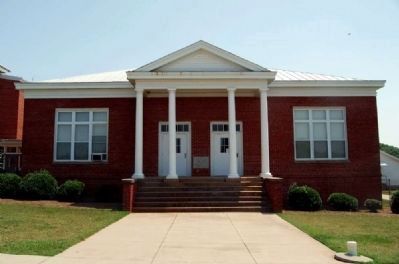Gray Court in Laurens County, South Carolina — The American South (South Atlantic)
Gray Court Owings Consolidated High School
Dials, New Harmony
Friendship, Owings
Gary Court, Riddles Old Field
Dedicated to our children
1928
Kate V. Wofford, County Supt. of Education
C.B. Owings, R.L.Gray, T.H. Babb
Board of Trustees
Erected 1928.
Topics. This historical marker is listed in this topic list: Education. A significant historical year for this entry is 1928.
Location. 34° 37.15′ N, 82° 7.368′ W. Marker is in Gray Court, South Carolina, in Laurens County. Marker can be reached from State Highway 14. Touch for map. Marker is at or near this postal address: 9210 South Carolina 14, Gray Court SC 29645, United States of America. Touch for directions.
Other nearby markers. At least 10 other markers are within 7 miles of this marker, measured as the crow flies. Laurens County Training School (approx. one mile away); Francis Rapley Owings House / Owings (approx. one mile away); Dials Methodist Church (approx. 2.7 miles away); Young’s School (approx. 5.1 miles away); Charles G. Garrett Interchange (approx. 6.2 miles away); Cherokee Boundary (1767) (approx. 6.3 miles away); Tullyton (approx. 6.3 miles away); Fountain Inn Cemetery (approx. 6.4 miles away); Fountain Inn Rosenwald School (approx. 6.7 miles away); Clayton "Peg Leg" Bates (approx. 6.8 miles away). Touch for a list and map of all markers in Gray Court.
Also see . . .
1. Gray Court-Owings School. The Gray Court-Owings School is significant as an excellent and largely intact example of Colonial Revival style school architecture in the upstate and for its association with the growth and development in education in northern Laurens County in the first half of the twentieth century. (Submitted on June 12, 2011, by Brian Scott of Anderson, South Carolina.)
2. Colonial Revival Architecture. The Colonial Revival (also Georgian Revival or Neo-Georgian) was a nationalistic architectural style, garden design, and interior design movement in the United States which sought to revive elements of Georgian architecture, part of a broader Colonial Revival Movement in the arts. (Submitted on June 13, 2011, by Brian Scott of Anderson, South Carolina.)
Additional commentary.
1. Gray Court-Owings School
Description
Gray Court-Owings School, on S.C. Highway 14 in the northern Laurens County town of Gray Court, is a two-story central brick building constructed in 1914 with a flanking one-story brick-veneered high school building to the north and one-story brick-veneered auditorium to the south, both build in 1928. With the flanking buildings, designed in the Colonial Revival style with Tuscan order porticoes, were added in 1928, a two-story portico of the Tuscan order was added to the entrance of the 1914 building. The 1914 building, currently housing the third and fourth grades, features a classical arrangement with basement level below a water table and two upper floors under a complex hipped roof clad with standing seam metal. Originally designed in the Renaissance Revival style with baroque massing, the building assumed a Classical or Colonial Revival appearance in 1928 when a shallow monumental tetrastyle (four columns) portico was placed with a central recessed pavilion.
The building is accessed by a monumental stair with flanking wide cast stone-capped cheek walls. Its central entrance is modified but set within a historic segmented arched bay. Except for those on the basement level, all windows, arranged in narrow pairs within the portico, in triple arrangement to either side of the portico, and quadruple arrangement on the side elevations, were replaced by 1950 with architectural glass block and a small lower operable sash.
The one-story high school pavilion to the north has a central
entrance with double-leaf door, sidelights, corner lights, transom and pediment within a tetrastyle portico of the Tuscan order. A truncated hipped roof, clad with standing seam metal and pierced on either side elevation with a pedimented dormer, shelters the building. Windows, with one-over-one sash with transoms, are arranged in triple formation to either side of the porticoed entrance and in multiple groupings on either side elevation.
To the south of the main building is the one-story auditorium pavilion, the facade of which differs only slightly in that it has a double entrance with multi-light transoms and a tetrastyle portico with a slightly different intercolumniation. The building has a truncated hipped roof clad with standing seam metal. The side elevations differ in that they feature full-arched window openings with keystones, sixteen-over-sixteen light, double-hung sash and multi-light compass-headed transoms. At least one of these windows has been modified with an additional double-leaf entrance.
In the 1930s a one-story frame potato house with a single-leaf entrance on the gable end, high, shuttered windows along the side elevations, and a roof with knee brackets and multiple roof ventilators was built to help Laurens County framers preserve their crops. This building contributes to the historic and architectural character of the property.
Two noncontributing resources are within the nominated boundaries: a ca. 1955 aluminum gymnasium building with brick-veneered front portion, and a 2002 multi-purpose one-story brick-veneered building containing classrooms, library, and cafeteria.
Significance
The Gray Court-Owings School, built in 1914 and expanded in 1928, is significant under Criterion C as an excellent and largely intact example of Colonial Revival style school architecture from early twentieth century upstate South Carolina. It is also significant for its association with the growth and development of education in northern Laurens County in the first half of the twentieth century.
Gray Court-Owings School was founded in 1902 on this site; the first school building was a small frame structure. The school included the first through ninth graded until 1921, with it was added the tenth grade. In 1914 the current two-story brick building was constructed in the Renaissance Revival style. In 1928 a two-story monumental Tuscan order portico was added to the 1914 building. That same year a high school building was built on the site just north of the 1914 central block; it included the eleventh grade and added the twelfth grade in 1949. The auditorium just south on the 1914 school was constructed at the same time. It was probably about 1949 that changed were made to the windows in the main building; however, they are alterations that do not significantly impact the complex's overall architectural and historic character.
The potato house was built during the 1930s in an effort to assist Laurens County farmers during the agricultural depression that proceeded and continued during the Great Depression. Professor S.C. Gambrell, who came to the Gray Court-Owings School in 1918, remained there for forty-five years, until 1962. Gambrell taught several classes, including agriculture and animal husbandry, and also served as superintendent of the school; his work included taking Gray Court-Owings students into rural Laurens County to plant muscadine and other grape vines, pecan, peach, and apple trees, and to undertake other work for county farmers. (Source: National Register Nomination Form.)
— Submitted June 12, 2011, by Brian Scott of Anderson, South Carolina.
Credits. This page was last revised on June 16, 2016. It was originally submitted on June 12, 2011, by Brian Scott of Anderson, South Carolina. This page has been viewed 774 times since then and 45 times this year. Photos: 1, 2, 3, 4, 5, 6, 7, 8, 9, 10, 11. submitted on June 12, 2011, by Brian Scott of Anderson, South Carolina.
